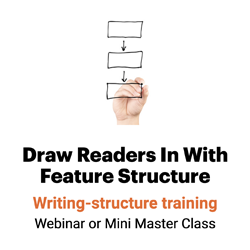WCB-Alberta takes on opioid addiction
I love it when my clients send me their rewrites after I present a writing workshop.

For one thing, it’s gratifying to see that people’s writing actually improves after I visit! For another, these pieces make great case studies in good writing.
Workers Compensation Board-Alberta writer Caren did a wonderful job rewriting an article during my Catch Your Readers workshop. Notice how her rewrite:
- Focuses the angle on reader benefits. Caren moves from event to impact. Her original story angle was WCB’s new opioid claim rollout. The rewrite focused on how employers can help save employees from addiction and overdose by using the board’s new resources.
- Uses the feature structure. This approach has been proven in the lab to be more effective at reaching readers. It also allows writers to plug and play their information into an existing format, saving time and effort.
- Keeps the piece short. The revised piece weighs in at fewer than 200 words — a one-minute read. So you can use the feature structure even when you don’t have a lot of space.
Here’s how she did it, with a great blog-post structure that works every time:
1. Lead
The original lead focused on background — in this case, a history lesson:
There’s a reason the feature structure places the background in the third paragraph, not the first. Background — otherwise known as the blah-blah — doesn’t grab readers’ attention.
Instead, write a lead that hooks the reader with a startling statistic or another concrete, creative, provocative lead. That’s what Caren did in her rewrite:
2. Nut graph
Caren didn’t include a nut graph in her original news story, because inverted pyramids don’t have nut graphs.
But in her rewrite, she puts the story “into a nutshell” — and shows readers how they’ll benefit from the piece:
3. Body
The original angle of the body is how the sausage was made. It’s not very interesting to clients whose employees are abusing opioids.
- Moving opioid claim management to a point where it is an integrated part of claim management;
- Establishing key measures that report on the status of opioid claim management;
- Increased director, manager, supervisor, and claim owner accountability;
- Improved consistency on how the policy is applied; and
- Updated opioid procedures, forms, letters, and the introduction of opioid-specific eCO enhancements.
Readers want to know, “What’s in it for me?”
The revised body focuses on the readers’ needs with a list of tips for dealing with the crisis:
- Familiarize yourself with the Opioid Claim Management process by referring to Business Procedure 40.11. Refresher training courses are also available through Business Training – talk to your supervisor about registering.
- Engage and empower your claimants – Know the clues of at-risk behaviour by using the Opioid Use Checklist (Form FM035AFC).
- Let Opioid Claim Management tools guide you throughout the process. You’ll find business procedures, policy, letter templates, tip sheets and tutorial videos.
4. Wrapup
There’s nothing wrong with this call to action, but it isn’t very rousing:
In Caren’s rewrite, on the other hand, the wrapup is nice, neat and sweet:
5. Kicker
Here Caren ends with a bang and comes full circle by referring back to statistics in the lead:
How to structure a blog post
Next time you start writing your blog post or social media post, try the feature structure. It’s been proven in the lab to get a lot of people to read your post and share your post. It’s the best writing skill you can use to write successful blog content.
Learn how to write feature stories, do keyword research for search engine optimization and more in our online courses.

Leave a Reply